- Gates Main
- Jaffa Gate
- Zion Gate
- Dung Gate
- East Gate (also known as Golden Gate)
- Lion’s Gate
- Herod’s Gate
- Damascus Gate
- New Gate
What is East Gate?
East Gate, is often counted among the so-called “gates of the Old City” despite it being sealed up. There are other gates in the wall but not often referred to as gates of the Old City. These include the Huldah gates, which are sealed, and the Tanner’s Gate, which is not sealed.
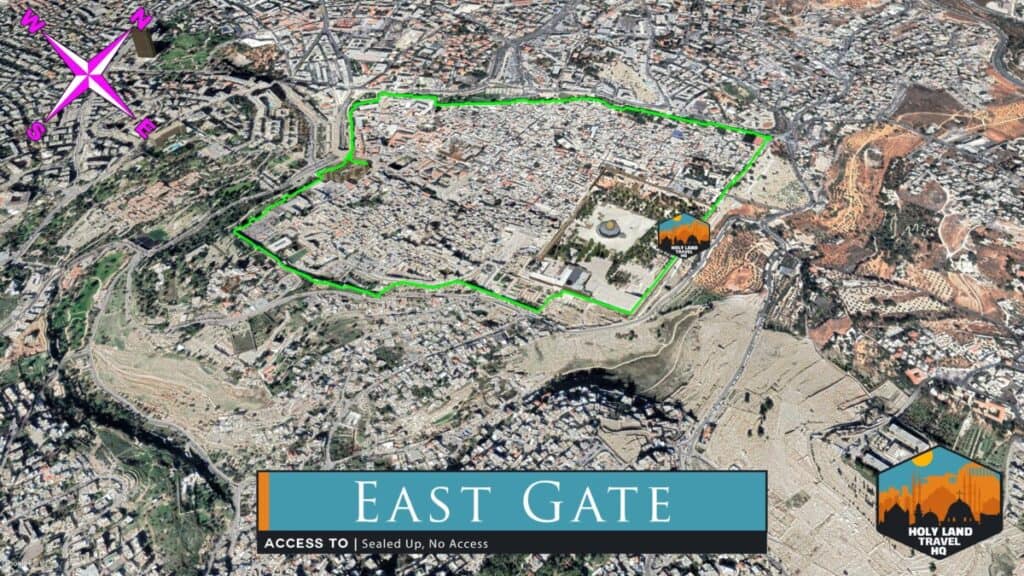
Of all the gates of the Old City, East Gate is the most intriguing for two reasons. The first is its connection to biblical prophecy, and the second is its dating. But before we go any further, we need to discuss the names associated with East Gate.
The historical name for the gate is East Gate. This is the name that Nehemiah uses in Nehemiah 3:29. The Gate is also known as Golden Gate, the Gate of Mercy, and the Shushan Gate. For the sake of simplicity, I will refer to it as East Gate
What are the Hebrew, Muslim, and Christian names for East Gate?
The Hebrew name for East Gate is Sha’ar Harachamin (שַעַר הָרַחַמִים), or the ‘Gate of the Mercy.’
Muslims have two names for the gate, one for each passageway. The northern passage is named Bab el-Taubah (باب التوبة), or the Gate of Repentance. And the southern passage is named Bab el-Rahma (باب الرحمة), which means Gate of Mercy.
Christians call it the Golden Gate. This name developed in a roundabout way. In Acts 3, Peter and John go up to the Temple to pray and they find a man begging next to the “Temple Gate called Beautiful.”
Etymology of East Gate’s names.
The Greek word for beautiful is ωραίος (pronounced: oraíos). As Christianity spread in Europe, many Latin-speaking pilgrims headed to the Holy Land to visit Jerusalem. The Greek word ωραίος sounds very much like the Latin word AVRIOLVS (pronounced: auriolus) which means gold, or golden.
Where scholars believe the Gate Called Beautiful really was.
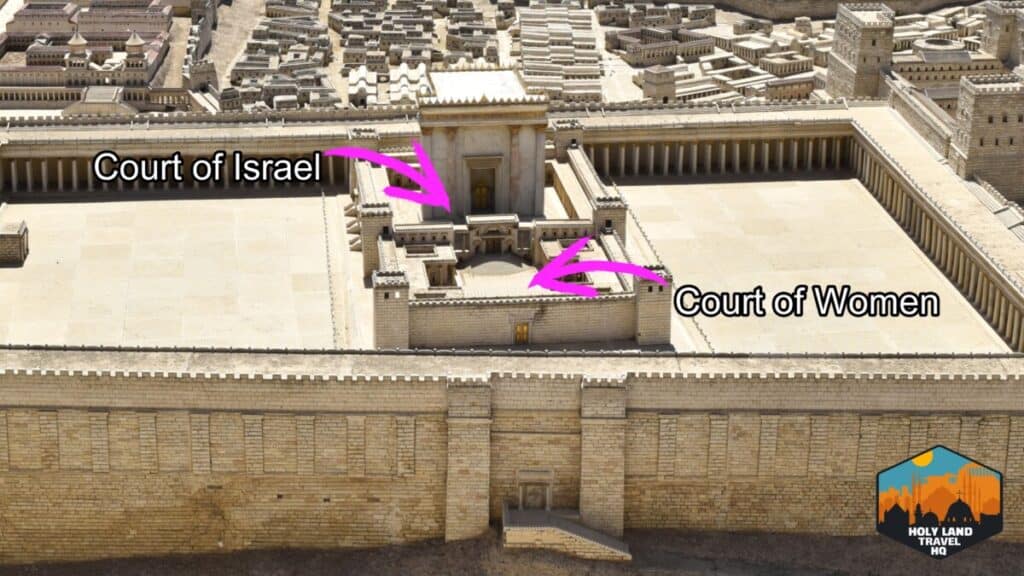
Many scholars believe that Peter and John were actually up on the Temple Mount though, not at East Gate. This is because the Beautiful Gate is described specifically as a temple gate. This is most likely true because Peter and John are then described as being on Solomon’s Colonnade, which was on top of the Temple Mount, outside of the Temple Courts.
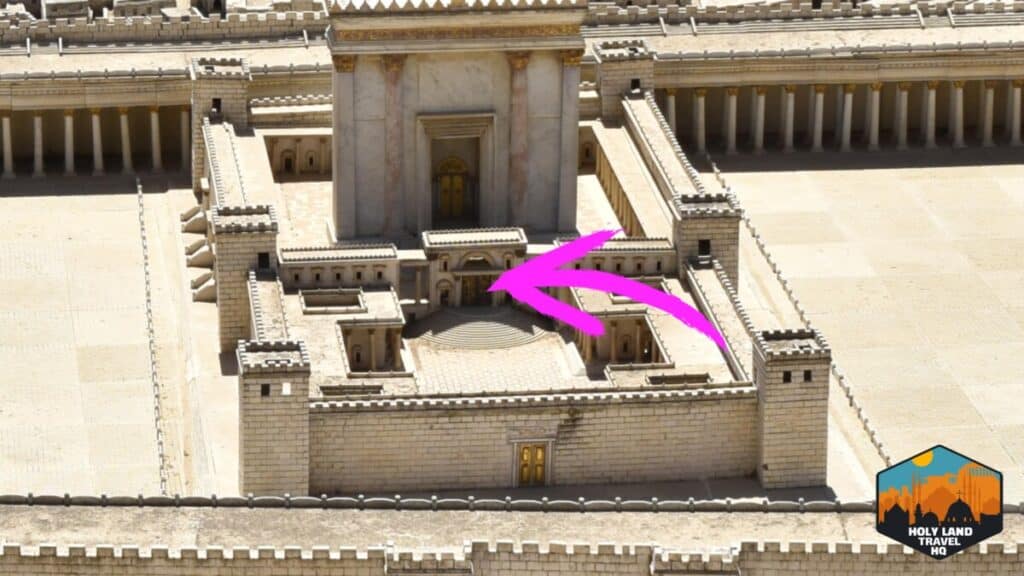
Scholars, such as Todd Fink of HolyLandSite.com, argue that the Beautiful Gate is another name for the Nicanor Gate. This is the gate that separated the Court of Women from the Court of Israel where the men performed sacrifices on the altar. Todd cites Josephus who describes the Nicanor Gate as greatly exceeding the other temple gates.
In contrast, Leen Ritmeyer lays out why he believes neither the Nicanor Gate, nor the East Gate can be the Gate called Beautiful.
Ritmeyer argues that the beggar, who seemed to have an infirmity, would not have been allowed on the Temple Mount until he was healed. In Acts 3:8 the healed man walks into the temple courts with Peter and John. Ritmeyer concludes that The Gate Called Beautiful was not associated with the Nicanor Gate inside the temple courts.
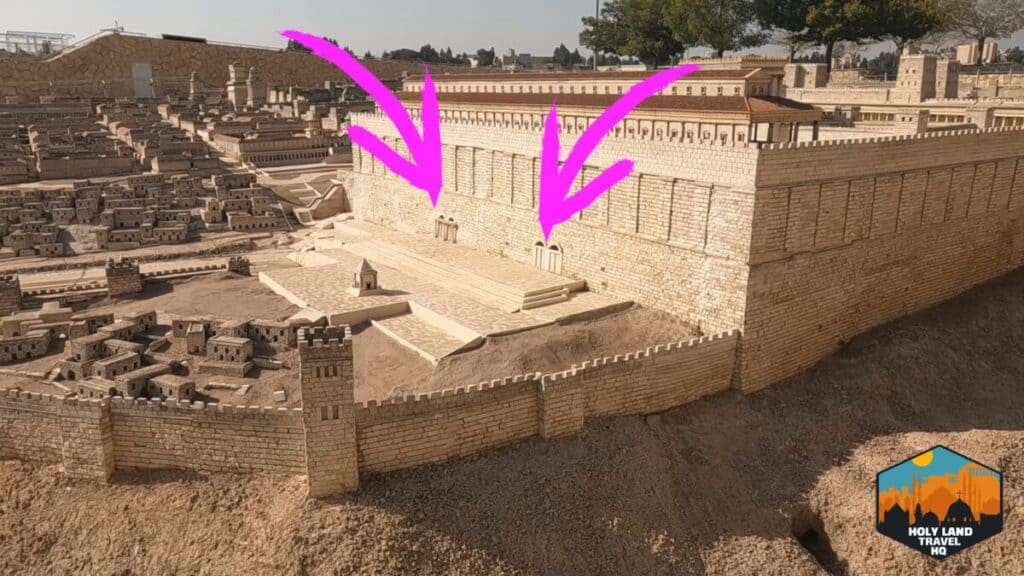
The East Gate, according to Ritmeyer, is a poor option to be the Gate Called Beautiful as well because it was exclusively used for ceremonies and a beggar would have wanted to be next to a high-traffic gate. Not a low-traffic one. Ritmeyer places the real Beautiful Gate at the Southern end of the Temple Mount where the main entrance was.
Where was the beggar likely to have been?
I think that there is truth in both arguments. The East Gate cannot be the Beautiful Gate because it had little to no traffic going through it due to it’s ceremonial status. But I don’t believe the Beautiful Gate was one of the southern Temple Mount gates. I agree with Todd Fink that the beggar was on top of the Temple Mount despite his infirmity. I would argue that when Luke states that the beggar was outside the Gate Called Beautiful, he was saying in simple terms that the beggar was outside the Temple Courts but on top of the Temple Mount.
Having traveled to many holy sites myself, beggars always seem that make their way into areas they are not supposed to be. Even today, in the Western Wall complex, beggars make their way around the crowd down by the wall.
How East Gate became Golden Gate.
But how did the East Gate come to be called Golden Gate? I would argue that after the Romans destroyed the Temple and tore down the Nicanor Gate, Latin-speaking Christians associated East Gate with the Beautiful Gate because it faced East. The Temple and the Nicanor Gate specifically faced east and without a Temple anymore, Jews and Christians presumably went to the next best thing. Over time Latin-speaking Christians, using the Latin word auriolus, inadvertently changed the name from Beautiful to Golden.
East Gate is also known as the Shushan Gate.
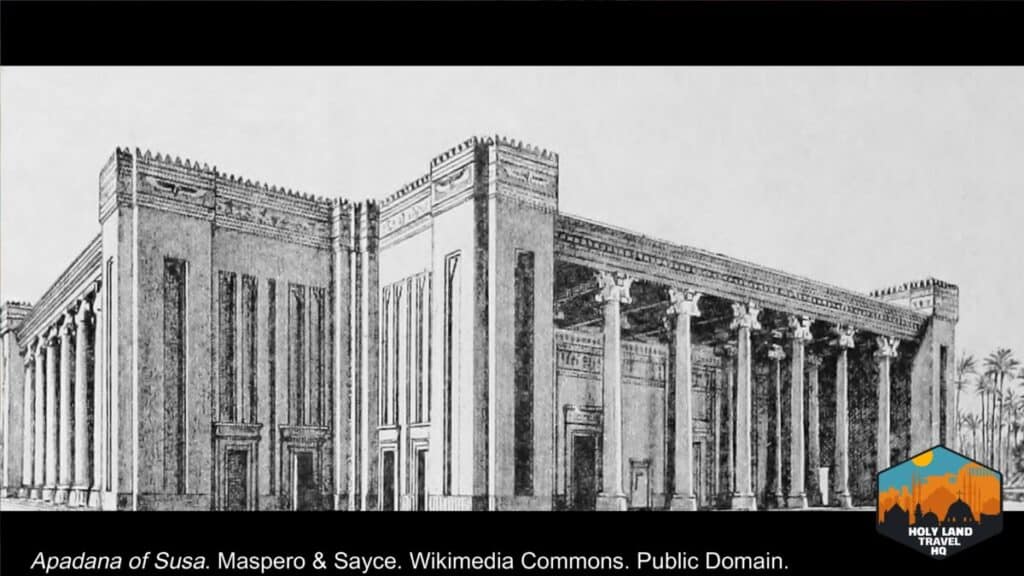
Another name that has been associated with East Gate is the Shushan Gate. Mishnah Middot 1:3 explains that five gates entered the Temple Mount during the Second Temple Period. It also states that the East Gate had a relief or some kind of decoration above it that depicted the Palace of Shushan.
Shushan is the Hebrew pronunciation for the city of Susa, which was the capital of the Elamite Empire in Persia. It is also where many of the Hebrews returned from after the exile of the 6th Century BC. The relief above the gate that depicted the palace of Shushan was most likely meant to remind anyone who walked through it, of the exile. As well as the mercy given to them by the Achaemenid King Cyrus the Great.
Being the only gate that has ever been found in the Eastern Wall of the Temple Mount, it can be reasonably assumed that the gate we see today is the same one. And since its construction, it’s gone through several renovations.
East Gate’s connection to Biblical prophesy.
The first reason why East Gate is intriguing is it’s connection to the prophecies of the Messiah in Ezekial 44:1-3 and Zechariah 9:9.
In the Old Testament Ezekial states.
1 Then the man brought me back to the outer gate of the sanctuary, the one facing east, and it was shut. 2 The LORD said to me, “This gate is to remain shut. It must not be opened; no one may enter through it. It is to remain shut because the LORD, the God of Israel, has entered through it. 3 The prince himself is the only one who may sit inside the gateway to eat in the presence of the LORD. He is to enter by way of the portico of the gateway and go out the same way. -Ezekiel 44:1-3
All three Abrahamic religions believe that East Gate will be the location where the messiah will enter the city.
In the Gospels, East Gate is not directly mentioned in Jesus’s Triumphal entrance into the city. However, being the only gate on the eastern wall of the Temple Mount, it’s highly likely that East Gate is the gate that Jesus passed through. And it makes sense that the Sanhedrin would be upset if he did in fact do this because of the prophetic nature of the act. The events of Jesus fulfilling the prophesy of Zechariah 9 are told in John 12:12–15, Matthew 21:4–9, Mark 11:7–10, and Luke 19:35–38.
East Gate’s restricted access.
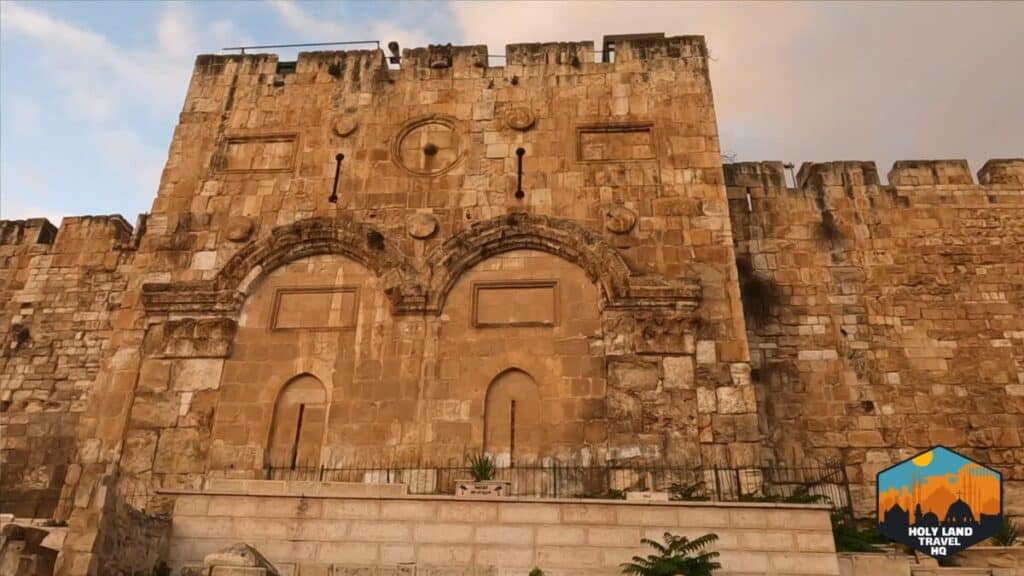
Because of this connection, many Christian pilgrims want to see East Gate. Unfortunately, access to the gatehouse is restricted. Only Muslims are allowed inside. One can see the back side of the gatehouse from the Temple Mount. However, the front side is the easiest to view. Visiting the gate can be disappointing though. If the Muslim cemetery outside the Eastern Wall isn’t a deterrence, then the iron fence around the gate will be. The fence hasn’t been there very long though. It was erected in 1978.
The history of the Muslim cemetery.
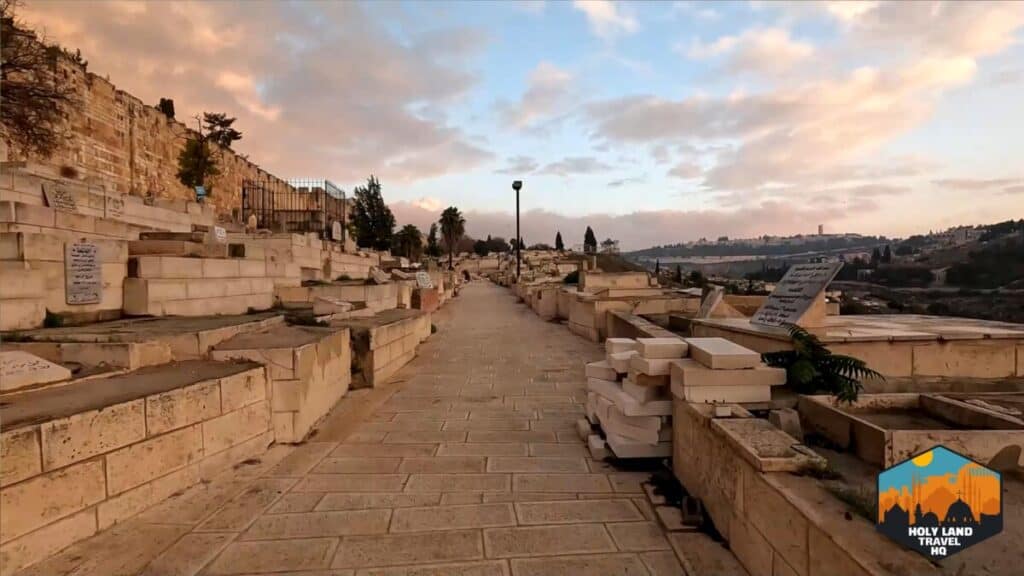
Many tour guides will tell you that the Muslim cemetery is next to the Eastern Wall of the Temple Mount to prevent the Jewish Messiah from entering the city. In Muslim, Jewish, and Christian prophesy, the messiah will come from the East and enter the city.
As the story goes, Muslims started the cemetery because they think that it will prevent the Jewish messiah from entering the city. Jewish religious tradition states that dead bodies are unclean, thus the bodies in the tombs will make the Messiah unclean as he passes through the cemetery. However, as Christians we know that whatever is unclean, Jesus makes clean.
Jesus entered the city through East Gate before without any problems, and he’s going to do it again.
Why is East Gate sealed up?
Another story that tour guides will tell you is that the Muslims also sealed up the gate in order to prevent the Messiah from being able to enter the city. The gate was sealed in 1187 AD after Saladin retook Jerusalem. It’s more likely that Saladin sealed the gate up for security reasons as the gate does not have any security features like a 90-degree turn or a mashikuli.
How old is East Gate?
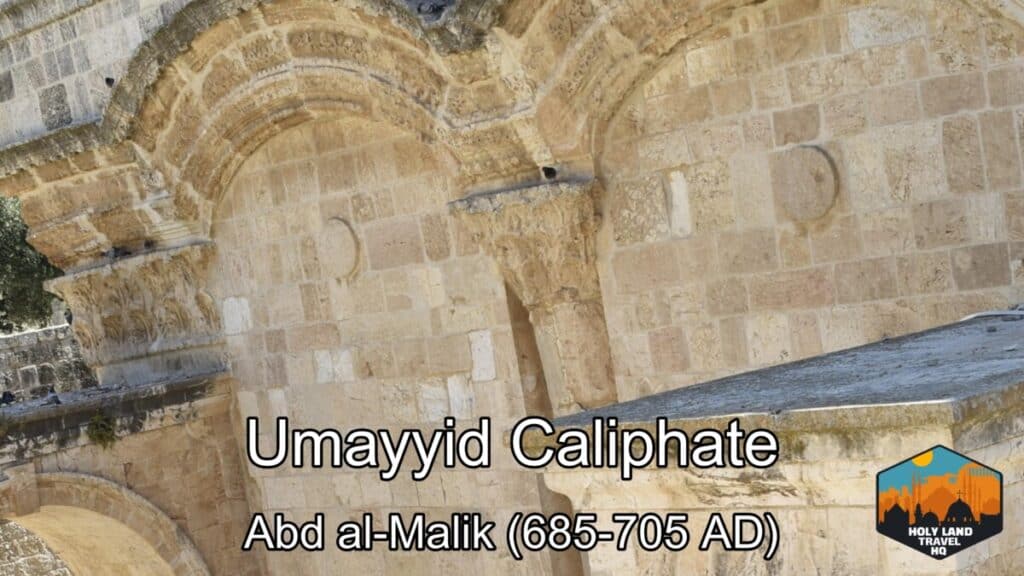
The second reason for the intrigue surrounding East Gate is its dating. Whereas the dating of the other gates has been rather forthright through plaques and analysis of architecture, East Gate has several layers of history to it. Despite what some scholars try to argue, East Gate was clearly not built by the Ottomans under Suleiman the Magnificent. However, we do know that he had a watchtower built on top of it.
The decorative arches on the back side indicate that the gatehouse was built during the early Islamic Umayyad period. So roughly the 7th century AD. But the gatehouse isn’t as intriguing as what lies underneath it.
What’s under East Gate?

In 1969, Archaeology student James Fleming was exploring the city walls and, in particular East Gate. When he got up close to the gate the ground beneath him opened up and he fell 8 feet into a hole at the base of the structure.
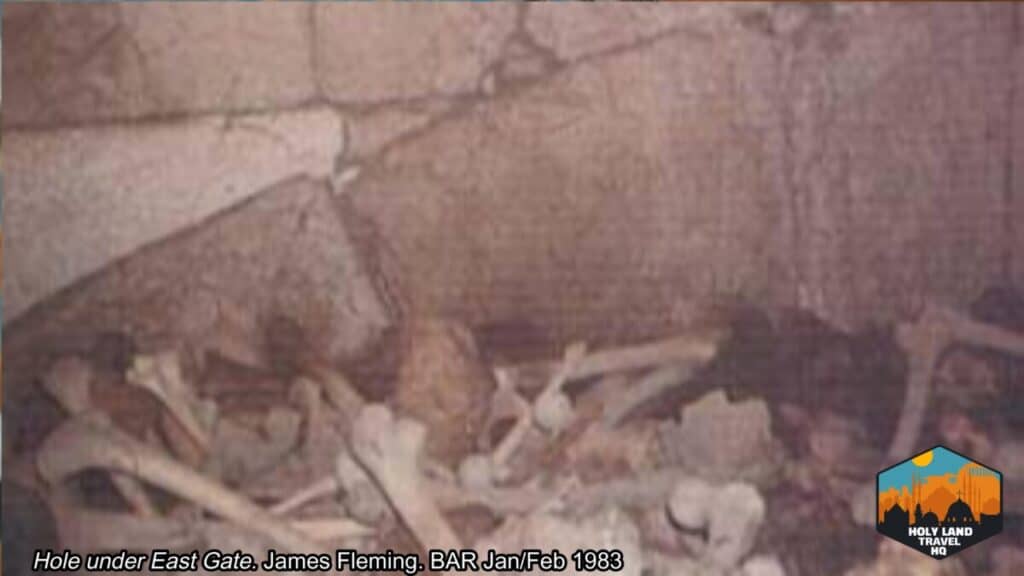
Inside Fleming found somewhere between 20-30 human skeletons. Many of the remains were still connected by cartilage, which indicated to Fleming that this was not only a mass grave of some sort, but that these people had died within the last 100 years. We can only speculate about the story behind why these people were buried here.
The human remains were fascinating, but just as surprising was the arch in the wall directly beneath the gatehouse of East Gate. Fleming determined the arch to be one of the original doorways of East Gate when the first temple was built. However, scholars have since determined the arch to be part of a stepped ramp that led up to the original East Gate. Based on the masonry, the dating of this ramp goes back to the Second Temple Period and Herod’s Temple Mount expansion project. So, the 1st and 2nd centuries BC.
What’s inside the East Gate gatehouse?
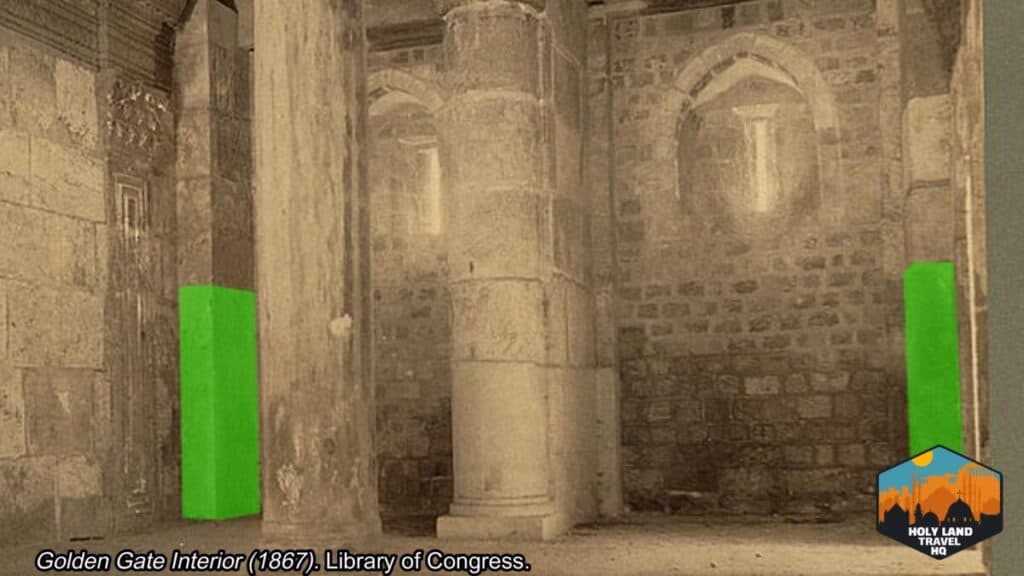
The ramp idea makes sense since the gatehouse, which again was added in the early Islamic period, protrudes out from the wall. It sits on top of the upper platform of the ramp. This would potentially mean that behind the east-facing façade, stand the original passageways of East Gate. And this is exactly what has been found.
Inside the gatehouse, the arches of the east-facing facade rest on two monolithic gateposts. These gateposts are each made of single stone blocks. This means that what they were originally intended for were door jambs. The masonry style dates back to the Iron Age, or rather to the time of Solomon and the first temple.
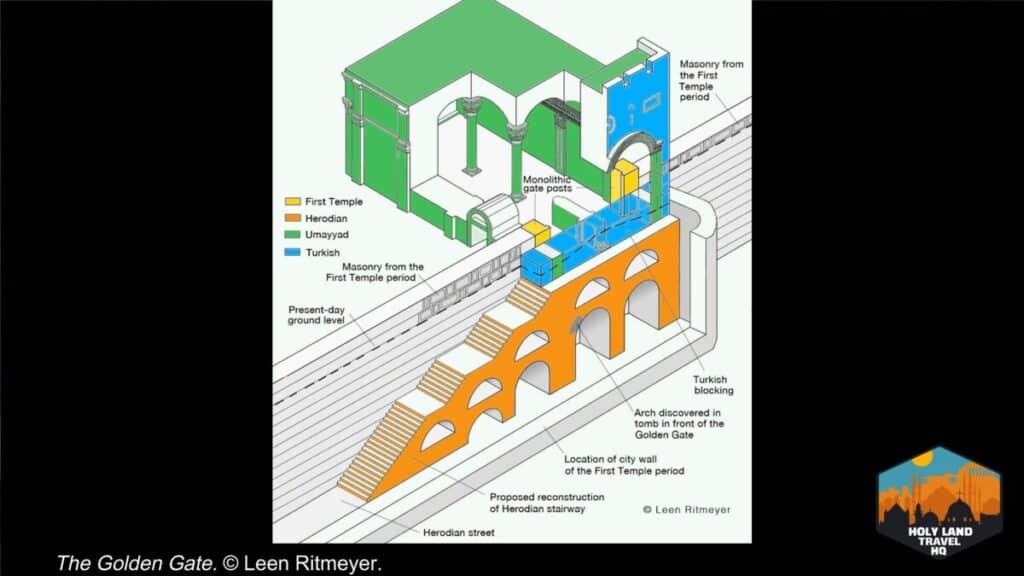
These gateposts are evidence of the original East Gate in the First Temple period. The ramp was added by Herod in the Second Temple period. And the gatehouse was added in the early Islamic Period. Further evidence of First Temple period dating is the masonry in the bottom layer stones on either side of the East Gate gatehouse.
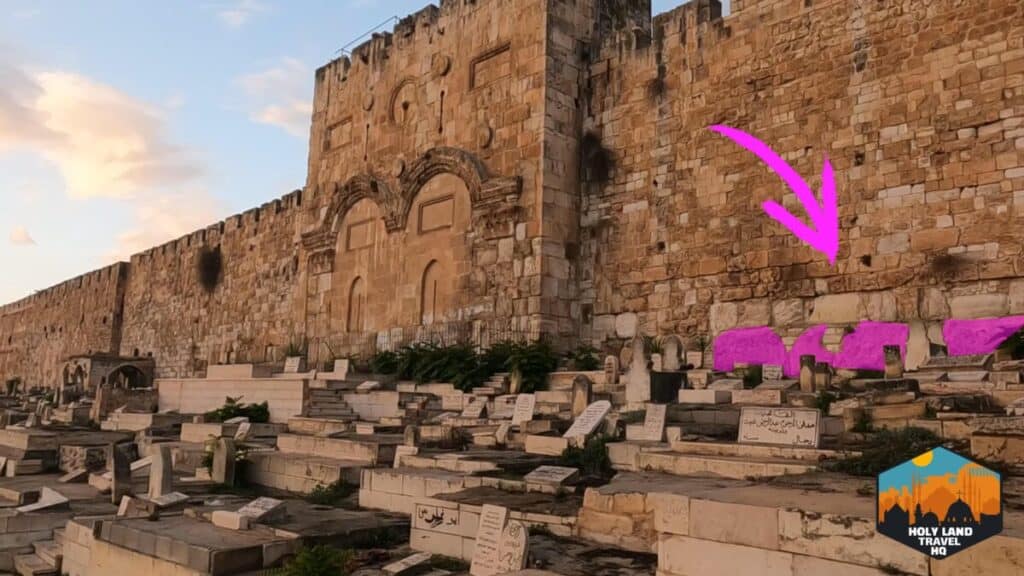
Taking all this information, we can confidently say that East gate was built somewhere between the time of Solomon in the 10th century, and Hezekiah in the 8th century BC. And since then, it has been renovated a few times.
https://madainproject.com/golden_gate_jerusalem
https://www.saxum.org/the-golden-gate-and-the-exaltation-of-the-holy-cross
https://www.templemount.org/visittemp.html
https://templeinstitute.org/illustrated-tour-the-inner-courts
https://www.jewishvirtuallibrary.org/nicanor-s-gate
https://www.ritmeyer.com/2022/10/05/the-beautiful-gate
https://www.ritmeyer.com/2010/12/14/the-beautiful-gate-of-the-temple
https://www.ritmeyer.com/2019/03/11/the-golden-gate-of-the-temple-mount-in-jerusalem
https://www.ritmeyer.com/2019/03/11/the-golden-gate-of-the-temple-mount-in-jerusalem
https://www.holylandsite.com/eastern-gate-jerusalem
https://historicalsitesinisrael.com/en/golden-gate-jerusalem
https://biblewalks.com/GoldenGate
Ritmeyer, Leen. The Quest: Revealing the Temple Mount in Jerusalem. Jerusalem: Carta, Jerusalem; The Lamb Foundation, 2015.
Edersheim, Alfred. The Temple, Its Ministry and Services as They Were at the Time of Jesus Christ. London: James Clarke & Co., 1959.
Hill, Craig Allen. “Golden Gate.” Edited by John D. Barry, David Bomar, Derek R. Brown, Rachel Klippenstein, Douglas Mangum, Carrie Sinclair Wolcott, Lazarus Wentz, Elliot Ritzema, and Wendy Widder. The Lexham Bible Dictionary. Bellingham, WA: Lexham Press, 2016.
Matev, Ami. “One Square Kilometer: The Old City – A Guide to the Sites. 2015. Old City Press.

